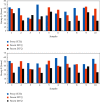Contrast Agent and Molecular Imaging Meta-Analysis of the Clinical Effect of Intelligent Image Sensor Combined with Visual Training in the Treatment of Children with Intermittent Exotropia in China
- PMID: 35313518
- PMCID: PMC8934207
- DOI: 10.1155/2022/5387928
Contrast Agent and Molecular Imaging Meta-Analysis of the Clinical Effect of Intelligent Image Sensor Combined with Visual Training in the Treatment of Children with Intermittent Exotropia in China
Retraction in
-
Retracted: Contrast Agent and Molecular Imaging Meta-Analysis of the Clinical Effect of Intelligent Image Sensor Combined with Visual Training in the Treatment of Children with Intermittent Exotropia in China.J Healthc Eng. 2023 Oct 11;2023:9834896. doi: 10.1155/2023/9834896. eCollection 2023. J Healthc Eng. 2023. PMID: 37860301 Free PMC article.
Abstract
At present, the main treatment for strabismus is still surgical treatment, but there is no unified standard for the evaluation of the timing of surgery. This study mainly explores the clinical effects of using meta-analysis of intelligent image sensors combined with visual training to treat children with intermittent exotropia. Cochrane systematic reviews collect, evaluate, and synthesize an increasing number of original clinical research results to obtain the comprehensive effect of relevant interventions, so as to provide real and reliable evidence for health decision-making and clinical practice. It uses scientific, clear, and reproducible research methods to reduce the influence of biased factors, so it is different from traditional reviews. Cochrane systematic reviews are especially suitable for certain interventions when the pros and cons of interventions are difficult to determine based on the results of a single clinical study or when there are large differences in the clinical application process. Poor quality systematic reviews can mislead policymakers and clinicians. In the meta-analysis, the Cochrane systematic evaluation method of evidence-based medicine was used to comprehensively search the published literature research on the treatment of intermittent exotropia with vision training. Using the Cochrane system evaluation method, computer search of CENTRAL, MEDLINE, Embase, Chinese Biomedical Literature Database, Chinese Journal Full-text Database, manual retrieval of relevant conference documents, and inclusion of all clinical trial documents of visual training in children with intermittent exotropia was conducted. Patients with intermittent exotropia were selected, simultaneous vision, fusion function, and far stereo vision with the same vision machine were measured, and near stereo vision with a stereo vision chart was measured. The number of simultaneous vision, fusion function, and distance and near stereo vision "with" and "without" cases were recorded for all patients, and the relationship with age of onset, type of strabismus, degree of strabismus, and degree of control was counted. Among them, 91 patients who underwent strabismus correction surgery were followed up for at least 6 months with correct eye position. The presence or absence of simultaneous vision, fusion function, far stereo vision, and near stereo vision were recorded and compared with preoperative. The number of recovery and nonrecovery cases was recorded, and the relationship between the age of operation, the type of strabismus, the degree of strabismus, and the degree of control was counted. It was statistically analyzed by SPSS22.0. The results of the meta-analysis showed that in terms of the effective rate of fundus lesions, the visual training group was better than the nontraining group, and the difference between the two groups was statistically significant (RR = 1.32, 95% CI: (1.25, 1.40), P < 0.0001). This study provides guidance for the early rehabilitation of children with intermittent exotropia.
Copyright © 2022 Haonan Sun et al.
Conflict of interest statement
The authors declare no conflicts of interest.
Figures










Similar articles
-
Analysis of Improvement Time and Influencing Factors of Diplopia after Intermittent Exotropia in Children.J Healthc Eng. 2022 Mar 14;2022:2611225. doi: 10.1155/2022/2611225. eCollection 2022. J Healthc Eng. 2022. Retraction in: J Healthc Eng. 2023 Dec 6;2023:9845658. doi: 10.1155/2023/9845658. PMID: 35320998 Free PMC article. Retracted.
-
[Clinical observation of bow-tie adjustable suture technique for overcorrection in intermittent exotropia].Zhonghua Yan Ke Za Zhi. 2023 Jul 11;59(7):542-549. doi: 10.3760/cma.j.cn112142-20221202-00615. Zhonghua Yan Ke Za Zhi. 2023. PMID: 37408425 Chinese.
-
[Clinical study on crossed disparity and uncrossed disparity in intermittent exotropia before and after surgery].Zhonghua Yan Ke Za Zhi. 2006 Feb;42(2):139-44. Zhonghua Yan Ke Za Zhi. 2006. PMID: 16643729 Chinese.
-
Intermittent Exotropia: The Effect of Alternating Occlusion Therapy on Control of Strabismus.J Binocul Vis Ocul Motil. 2024 Apr-Jun;74(2):78-83. doi: 10.1080/2576117X.2024.2340213. Epub 2024 Apr 22. J Binocul Vis Ocul Motil. 2024. PMID: 38648106 Review.
-
[Hot topics in treatment of intermittent exotropia].Zhonghua Yan Ke Za Zhi. 2015 Jun;51(6):465-9. Zhonghua Yan Ke Za Zhi. 2015. PMID: 26310122 Review. Chinese.
Cited by
-
Non-surgical treatment of strabismus in children: a review of recent advances.Front Med (Lausanne). 2025 Jun 27;12:1582284. doi: 10.3389/fmed.2025.1582284. eCollection 2025. Front Med (Lausanne). 2025. PMID: 40655112 Free PMC article. Review.
-
Retracted: Contrast Agent and Molecular Imaging Meta-Analysis of the Clinical Effect of Intelligent Image Sensor Combined with Visual Training in the Treatment of Children with Intermittent Exotropia in China.J Healthc Eng. 2023 Oct 11;2023:9834896. doi: 10.1155/2023/9834896. eCollection 2023. J Healthc Eng. 2023. PMID: 37860301 Free PMC article.
References
-
- Seo D., Oh S., Shin S., Lee M., Hwang Y., Seo S. Smartphone compatible on-site fluorescence analyzer for spilled crude oil based on CMOS image sensor. Sensors and Actuators B: Chemical . 2019;289:93–99. doi: 10.1016/j.snb.2019.03.086. - DOI
-
- Nweke H. F., Teh Y. W., Al-Garadi M. A., Alo U. R. Deep learning algorithms for human activity recognition using mobile and wearable sensor networks: state of the art and research challenges. Expert Systems with Applications . 2018;105:233–261. doi: 10.1016/j.eswa.2018.03.056. - DOI
-
- Ramesh S., Yaashuwanth C. Enhanced approach using trust based decision making for secured wireless streaming video sensor networks. Multimedia Tools and Applications . 2020;79(15):10157–10176. doi: 10.1007/s11042-019-7585-5. - DOI
Publication types
MeSH terms
Substances
LinkOut - more resources
Full Text Sources
Miscellaneous

